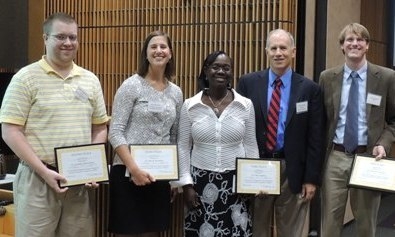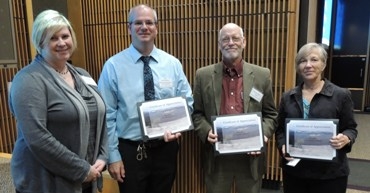by Christie Sayes, NCSOT Vice President-Elect

The North Carolina Regional Chapter of the Society of Toxicology (NCSOT) held its Annual Fall Meeting on October 4, 2012, on the campus of the National Institute of Environmental Health Sciences (NIEHS) in Research Triangle Park, North Carolina. Approximately 90 area professionals and students attended this year’s meeting themed, Back to the Basics: Whole Organism Toxicity Assessments.
As conducted in previous years, NCSOT hosted a lunch and career panel discussion for graduate students and postdoctoral fellows.The panelists included Marla Goonan, Rajendra Chhabra, National Toxicology Program; Tammy Collins, NIEHS; Stephanie Padilla, US Environmental Protection Agency; Gerald LeBlanc, North Carolina State University, and Victor Johnson, Burleson Research Technologies, Inc.
Immediately after the luncheon, Michael Hughes, the current NCSOT President, opened the meeting with introductory remarks and review of recent business. He then announced the 2012 President’s Award for Research Competition (PARC) winner: Benjamin Moeller, University of North Carolina at Chapel Hill. As part of the award ceremony, Benjamin presented his more recent findings in a keynote presentation, entitled “Biomarkers of Exposure and Effect in Human TK6 Cells Following [13C2]-Acetaldehyde Exposure.”
 The meeting then moved on to the plenary session that was organized by Jamie DeWitt, the current NCSOT Vice President. Speakers and presentation titles included: Dr. Padilla, “Reeling in the Data: Chemical Screening for Neurotoxicity Using Larval Zebrafish;” Dr. LeBlanc, “Complexity and the Need for Whole Organism Testing in Endocrine Toxicology,” and Dr. Johnson, “Host Resistance Models: Investigations into the Overall Health of the Immune System for Risk Assessment.”
The meeting then moved on to the plenary session that was organized by Jamie DeWitt, the current NCSOT Vice President. Speakers and presentation titles included: Dr. Padilla, “Reeling in the Data: Chemical Screening for Neurotoxicity Using Larval Zebrafish;” Dr. LeBlanc, “Complexity and the Need for Whole Organism Testing in Endocrine Toxicology,” and Dr. Johnson, “Host Resistance Models: Investigations into the Overall Health of the Immune System for Risk Assessment.”
Overall, the NCSOT Annual Meeting was successful by promoting career development for graduate students and postdoctoral fellows and because of the three-cutting edge presentations on whole organism toxicity assessments of critical organ systems.